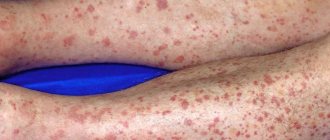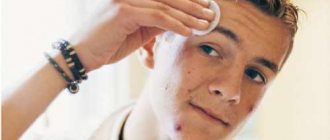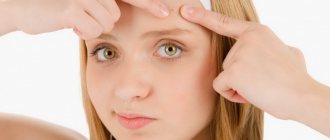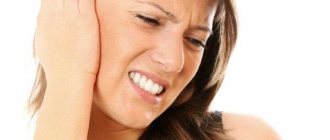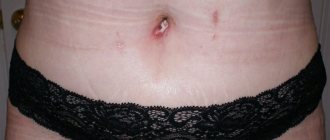Papular acne is the formation of papules on the skin, which are bumps with a hard consistency and a size of more than 1 centimeter. They are visible to the naked eye and can be felt under the finger when touched. Follicular lesions are mainly located on the facial skin in the T-zone, that is, on the forehead, nose and chin. This is an area of increased sebum and sebum production.
Papular acne is the most common and problematic form of acne. Treatment of papular acne requires medication and proper care.
Causes of formation of papular acne
The problem of papular acne mainly affects young people. In girls, this type of acne is usually more mild.
The changes that appear on the skin during the formation of papular acne are caused by the so-called hormonal storm. At a young age, hormone levels rise rapidly, causing the sebaceous glands to produce more sebum, which does not have time to be removed naturally.
Under physiological conditions, the production of sebum is necessary to create a protective layer on the skin that protects it from external factors. However, its excess, combined with exfoliating epidermis, sweat and dust from the environment, causes clogging of the sebaceous tubules and the appearance of acne, nodules and papules.
Bacteria multiply under the skin, and an inflammatory reaction develops, which is manifested by pain, pinpoint swelling and redness of the facial skin.
Papular acne in adults is caused by excessive stress, inadequate facial care, or problems with hormone (androgen) secretion. The most common problem of adult acne occurs in women, such as during menstruation or pregnancy. Papular changes are accompanied by pimples and acne.
Acne marks
Post-acne is the unpleasant marks that acne can leave behind: lumps and scars, changes in skin color in certain areas, red spots from acne, enlarged skin pores, the appearance of a vascular pattern (rosacea), sometimes even deep scars. Dermatologists combine all these skin changes under the term post-acne (“post” - after, “acne” - pimples, blackheads). The more severe the acne disease, the more pronounced the signs of post-acne will be. Even after non-acute, but long-term processes, quite noticeable scars and depressions can remain. The main reasons for the occurrence of post-acne are improper treatment or lack thereof during the period of skin lesions with acne, mechanical removal of contents, lack of proper facial skin care, and also if the patient did not turn to specialists for help and did not use specially selected treatment products, then the likelihood of that scars and spots form after acne increases several times. If the form of acne is severe, the rashes are deep, for example cysts, nodules, then during healing there will always be scars, so it is very important to start proper acne treatment on time so that as few such forms of acne form as possible.
The most common acne marks are:
- Scars . Acne scars usually remain after inflammatory processes that affected the deep layers of the skin and were accompanied by abundant formation of pus, with long-term difficulty in the release of pus from the inflamed area to the surface of the skin. In this case, the inflammatory reaction develops for quite a long time in a confined space, gradually spreads to nearby areas of the skin and ultimately seriously deforms them. Often the cause of scars is inept attempts to squeeze out pimples, resulting in deep skin damage that heals with the formation of a scar (most often atrophic). The color of acne scars changes over time: from the pink color of fresh scars to the color of normal skin about a year after appearance, but can also become hyperpigmented or, conversely, paler than the base color of the skin.
The following types of acne scars are known:
Atrophic scars - resemble a small rectangular or oval hole, the color of which is usually flesh-colored. This type is divided into rounded, chipped and rectangular scars.
Physiological scars are almost completely invisible on the skin and heal quite quickly.
Keloid scars - cause itching and other painful sensations, similar to hypertrophic scars. They form quite rarely on the surface of the face.
Hypertrophic scars are convex, pink, dense formations. They arise due to a huge amount of scar tissue.
- Vascular spots. Prolonged inflammation of the skin leads to disruption of blood microcirculation in these areas. An additional factor in their appearance is crude attempts to squeeze or open pimples. As a result, areas of burgundy, crimson, and bluish redness may appear. Without treatment, these acne spots can remain on the skin for a long time (sometimes more than a year). It is also possible that telangiectasia (visible vascular networks on the surface of the skin) may appear, which do not tend to go away on their own.
- Changes in skin pigmentation - dyschromia. Dyschromia is a disorder of skin color. With dark skin, acne marks may appear as light spots against the background of dark skin. With fair skin, dark spots appear at the sites of resolved rashes. The immediate causes of changes in skin pigmentation are prolonged inflammation and trauma to the skin due to inept attempts to squeeze out or open pimples. Areas of dyschromia can appear both under the influence of ultraviolet radiation and without it.
Registration for consultation
Post-acne treatment methods:
- Chemical peels - various acids are used to dissolve the stratum corneum of the epithelium. As a result, increased division of young cells begins and, as a result, the upper layer of the skin is leveled. With their help, you can make the transition of the surrounding skin into an atrophic, receding scar less noticeable or make a hypertrophic, protruding scar flatter. Peels are most effective on fresh acne scars (pink in color).
- Mesotherapy is a fairly effective modern method that allows you to saturate the skin with the most necessary substances and microelements. Its principle is to introduce into the skin compositions that include biologically active substances, vitamins, hyaluronic acid and various enzymes. For different types of scars and different stages of their growth, different drugs are used.
- Biorevitalization – hyaluronic acid is very important for proper skin healing. The use of biorevitalization in the early stages of scar formation allows you to avoid the formation of coarse scar tissue.
- Laser skin resurfacing allows you to minimize the effects of acne over several procedures. The method involves gently removing the upper keratinized layer; the laser also activates all biochemical processes, including the production of collagen, which provides the necessary elasticity of the skin. The doctor determines the number of required sessions individually for each patient. Their number depends on the condition of the skin and the presence of spots.
- Pulse light therapy - has a bactericidal effect, reduces inflammation, reduces the activity of the sebaceous glands, reduces redness (acts on small capillaries), stimulates the production of collagen fibers (scars become less noticeable). Used to treat if there are red spots from acne and red acne scars. The doctor also determines the number of required sessions individually for each patient.
It is important to remember that when choosing any method of combating post-acne and other consequences of acne, you must first consult a doctor, since only a dermatologist will be able to assess the degree and depth of post-acne, and prescribe not only an effective, but also an adequate method of treatment.
Prevention
Prevention of post-acne involves preventing exacerbations of acne and timely professional treatment of acne, preventing the appearance of deep purulent inflammations. And also in careful handling of inflamed areas and proper skin care. It is necessary to refrain from independently attempting to squeeze or otherwise open pimples. In most cases, it is precisely such attempts that aggravate the situation and lead to the formation of a scar at the site of the pimple, since when trying to squeeze out a pimple, its contents may rush not to the surface of the skin, but, on the contrary, into the depths and create a new focus of inflammation there, which will be much more difficult cure without scar formation.
Pimples on the head: why they appear, and is it possible to get rid of the rashes
Despite the fact that formations under the hair can be hidden from the eyes of others with a stylish hairstyle or a fashionable headdress, acne on the head causes a lot of trouble for their owners, associated primarily with itching and painful sensations when scratching.
In addition, it is impossible to see a comedon or papule - the condition of a pimple must be assessed by touch, and this also causes a certain psychological discomfort. The described problem is not always cosmetic and may indicate the presence of quite serious diseases in the body.
For this problem, we recommend contacting our Private Practice clinic, where highly competent dermatologists will determine the cause of the rash and prescribe the correct course of treatment. You can make an appointment at a convenient time: we are open 7 days a week from 09:00 to 21:00.
Internal and external causes of acne on the head
The patient himself can provoke the growth of rashes. Specialists at our clinic consider such reasons to be external. A dermatologist usually works with them. Often the following actions of patients lead to the appearance of acne in the hair:
- insufficient head hygiene - infrequent washing provokes blockage of the sebaceous glands, and shaving with dull trimmers and razors causes irritation of the skin, on which rashes may appear;
- hypothermia - in this case, acne first appears on the back of the head and temples, as the most unprotected areas, and also with thin skin;
- improper selection and use of cosmetics - shampoos that dry out the skin, too frequent dyeing with aggressive coloring compounds disrupt the water-fat balance of the epidermis of the head, creating an ideal environment for the appearance of acne. This also includes regular blow-drying and washing your hair with excessively chlorinated water;
- wearing hats made of synthetic fabric for a long time - the skin sweats in them, the ducts become clogged, and the sebaceous glands begin to actively secrete secretions, after which the appearance of purulent acne on the head is only a matter of time;
- taking steroid drugs.
Internal causes are more serious. In this case, acne on the head may indicate:
- hormonal disorders. Particularly often, as a result of hormonal imbalance, acne occurs on the scalp in premenopausal women, during pregnancy and with polycystic ovary syndrome, as well as in adolescents during the period of the so-called hormonal storm. In men, such symptoms may indicate a malfunction of the adrenal glands;
- incorrect functioning of the gastrointestinal tract: for example, acne in the temple area indicates that it is time to check the liver and gallbladder, and rashes in the back of the head indicate abnormalities in the intestinal microflora;
- weakened immunity, in which entire colonies of staphylococci and streptococci are found in the patient’s body during tests in the laboratory of our medical center;
- chronic stress;
- diseases acquired through sexual contact.
In addition, the appearance of formations in the scalp can be caused by poor nutrition with excess consumption of processed fats and simple carbohydrates.
Diagnosis and treatment
In our Private Practice clinic, specialists always use comprehensive treatment for acne in the hair, aimed not only at ridding the patient of external manifestations, but also at eliminating internal causes. In order to identify them, first of all, a comprehensive study is prescribed, which includes:
- blood tests - general, biochemical formula and certain types of hormones;
- scrapings from the scalp;
- stool analysis to study the state of intestinal microflora;
- if necessary, ultrasound of internal organs;
- studies to exclude the presence of STDs.
Only after determining the cause of acne, the clinic’s specialized specialists - a dermatologist, venereologist, endocrinologist and others - get down to business, jointly developing treatment tactics with both external means and drugs for internal use.
If you regularly have rashes on your head, this is a “signal” from the body that something is wrong. Don’t let the disease get worse, consult a doctor on time and be healthy!
You can make an appointment with a doctor by calling
+7+7 (495) 980-13-16
To push or not to push. 9 Myths About Acne You Should Stop Believing
Acne on the face is not only a problem for young people. Even if you passed adolescence twenty or even thirty years ago, this does not guarantee ideal skin without inflammation and blackheads. What to do with the problem, and most importantly, how not to aggravate it, says cosmetologist Inna Feronova .
1. We think : under no circumstances should you squeeze out pimples, otherwise there will be even more of them. However, if the pimple is “ripe”, it is better to get rid of it.
In fact : you can squeeze out pimples, but you need to do this with all the necessary precautions: wash your hands, treat the area where the pimple appears with a disinfectant (pharmaceutical alcohol or hydrogen peroxide) twice. Keep in mind that there are places on the face where you shouldn’t remove pimples yourself, as this is fraught with consequences: for example, purulent meningitis. These include the area of the wings of the nose and the nasolabial folds: there are blood vessels that supply the brain with blood. If disinfection rules are not followed, the infection can enter the bloodstream. It is also strictly forbidden to squeeze out pimples with yellow or green pus on your own. Another important point: acne is just the tip of the iceberg. In order to get rid of them, it is necessary to establish the cause of their occurrence, and this can only be done by a specialist - a dermatologist. Another compelling argument in favor of seeking medical help when it comes to acne is the risk of scarring at the site of a self-squeezed pimple.
Article on the topic Dangerous spots. Signs of which “female” diseases can be seen on the skin of the face
2. We think : the more sweet and fatty foods in the diet, the more acne on the face.
In fact : this point of view is long outdated. Experts do not associate the appearance of acne with flaws in the patients’ diet. Of course, having problem skin is a reason to reduce the amount of spicy, salty or sweet foods in your diet to a minimum. But that's not why acne occurs. There are a huge number of causes external (exogenous acne) and internal (endogenous acne) that lead to acne. In the first place are hormonal changes (puberty, premenstrual syndrome, pregnancy, etc.), the presence of endocrine diseases and problems with the gastrointestinal tract. The second is improper skin care. On the third - stress, ecology, bad habits. Also, the appearance of acne can be caused by taking hormonal drugs and steroids.
3. We think : professional facial cleansing at least once a month will minimize the risk of acne.
Fact : Acne is a disease that requires systemic treatment. Without establishing the cause of its occurrence and without undergoing a course of treatment, which involves taking appropriate medications and using ointments, you will not be able to get rid of acne, no matter how many times you do professional facial cleansing.
There are 3 degrees of acne severity: mild - no more than 10 acne without pronounced signs of inflammation, moderate - from 10 to 40 acne elements, and severe - more than 40 purulent elements. Treatment of acne directly depends on the severity of the disease. Mild acne involves local treatment with creams or ointments based on antibiotics and keratolytics with the addition of antiseptic ingredients. Such ointments help reduce sebum production. Moderate and severe forms of the disease require constant medical supervision; it is possible to take medications (antibiotics). From the “office” treatment, in addition to mechanical cleansing, patients with acne are shown chemical and laser peels. Phototherapy and cryotherapy (cryodestruction, cryomassage, etc.) give good results in the treatment of acne.
Article on the topic
Sallow complexion and acne. 8 signs that it's time for you to see a doctor
4. We think : foundation causes acne because it clogs pores.
Fact : This is one of the most common myths about acne. Modern high-quality foundations do not clog pores. Buy proven brands and don’t skimp on your health. Remember, a good foundation cannot be cheap. By the way, acne can be caused by an incorrectly selected face cream for your skin type. Some product may simply not be suitable for you and may cause an allergic reaction. Acne may appear because you neglect creams with UV protection. As a rule, problem skin is sensitive, so it requires more attention and care. Do not forget also about regular hygiene of those items that you use to apply foundation and other products. “Centuries-old” dirt on sponges, brushes and applicators is another reason for the appearance of exogenous acne.
5. We think : a clay mask helps fight acne.
In fact : I still wouldn’t put much faith in the miraculous powers of homemade masks to treat acne. I repeat, acne is a serious disease that requires identification of the causes and competent treatment from a specialist. A clay mask is a good remedy if you have oily or normal skin and pimples appear on it occasionally. But under no circumstances should you use it if your skin has inflammation, ulcers, or other serious problems!
Article on the topic
Elements of youth.
How to choose the right face cream 6. We think : if you don't have any medicine on hand, you can burn the pimple with toothpaste.
In fact : traditional medicine knows many ways to treat a wide variety of diseases. How successful she was in this is a big question. As a dermatologist, I cannot give advice on using toothpaste as a remedy for acne. If you encounter this problem regularly, try to have pharmaceutical antiseptics at home. In general, having a first aid kit at home is useful not only for acne. You should not aggravate your skin problems with the help of folk remedies - it is better to go to the pharmacy and buy hydrogen peroxide, calendula tincture, salicylic or boric alcohol, ichthyol or tetracycline ointment. All these products are applied pointwise and perfectly dry the area of inflammation.
7. We think : acne appears due to irregular sex.
In fact : another myth that has taken root in our minds for so long that it seems impossible to eradicate it. Many years of medical practice show that acne and the presence or absence of sex in a patient’s life are in no way connected. Again, the causes of acne can be external or internal, for example, hormonal or associated with taking any medications. In this case, oral contraceptives may be prescribed to treat acne. Despite the fact that the activity of the sebaceous glands is regulated by sex hormones, the absence of sex does not affect the production of skin secretion, nor does its presence.
Fat, dryness, pimple. The ABCs of caring for different skin types Read more
8. We think : if you scrub 1-2 times a week, it will help in the fight against acne.
In fact : this is where you need to be extremely careful. Problem skin is most often sensitive, so it is afraid of aggressive influences. Namely, this happens to skin that is intensively scrubbed. Only those whose skin is of normal type without signs of inflammation, especially without acne, can afford to use a scrub once a week. Scrubs are contraindicated for acne! If you have sensitive skin (dry or oily), use more delicate cleansers, such as gommages, for home care. And if the skin is problematic, then it is better to coordinate home care with a dermatologist and strictly follow his recommendations.
9. We think : acne heals faster in the sun.
In fact : the sun can provoke a new round of acne, so for problem skin it is recommended to constantly use SPF cream before going outside, even in winter.

